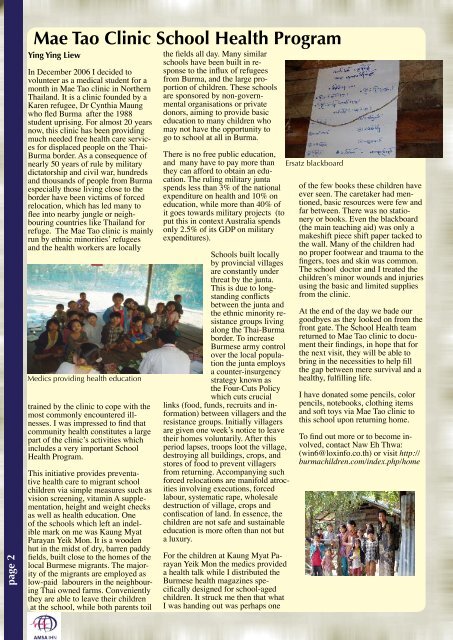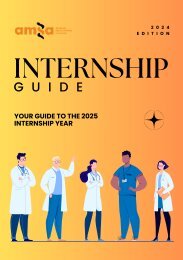Create successful ePaper yourself
Turn your PDF publications into a flip-book with our unique Google optimized e-Paper software.
page 2<br />
Mae Tao Clinic School Health Program<br />
Ying Ying Liew<br />
In December 2006 I decided to<br />
volunteer as a medical student for a<br />
month in Mae Tao clinic in Northern<br />
Thailand. It is a clinic founded by a<br />
Karen refugee, Dr Cynthia Maung<br />
who fled Burma after the 1988<br />
student uprising. For almost 20 years<br />
now, this clinic has been providing<br />
much needed free health care services<br />
for displaced people on the Thai-<br />
Burma border. As a consequence of<br />
nearly 50 years of rule by military<br />
dictatorship and civil war, hundreds<br />
and thousands of people from Burma<br />
especially those living close to the<br />
border have been victims of forced<br />
relocation, which has led many to<br />
flee into nearby jungle or neighbouring<br />
countries like Thailand for<br />
refuge. The Mae Tao clinic is mainly<br />
run by ethnic minoritiesʼ refugees<br />
and the health workers are locally<br />
Medics providing health education<br />
trained by the clinic to cope with the<br />
most commonly encountered illnesses.<br />
I was impressed to find that<br />
community health constitutes a large<br />
part of the clinicʼs activities which<br />
includes a very important School<br />
Health Program.<br />
This initiative provides preventative<br />
health care to migrant school<br />
children via simple measures such as<br />
vision screening, vitamin A supplementation,<br />
height and weight checks<br />
as well as health education. One<br />
of the schools which left an indelible<br />
mark on me was Kaung Myat<br />
Parayan Yeik Mon. It is a wooden<br />
hut in the midst of dry, barren paddy<br />
fields, built close to the homes of the<br />
local Burmese migrants. The majority<br />
of the migrants are employed as<br />
low-paid labourers in the neighbouring<br />
Thai owned farms. Conveniently<br />
they are able to leave their children<br />
at the school, while both parents toil<br />
the fields all day. Many similar<br />
schools have been built in response<br />
to the influx of refugees<br />
from Burma, and the large proportion<br />
of children. These schools<br />
are sponsored by non-governmental<br />
organisations or private<br />
donors, aiming to provide basic<br />
education to many children who<br />
may not have the opportunity to<br />
go to school at all in Burma.<br />
There is no free public education,<br />
and many have to pay more than<br />
they can afford to obtain an education.<br />
The ruling military junta<br />
spends less than 3% of the national<br />
expenditure on health and 10% on<br />
education, while more than 40% of<br />
it goes towards military projects (to<br />
put this in context Australia spends<br />
only 2.5% of its GDP on military<br />
expenditures).<br />
Schools built locally<br />
by provincial villages<br />
are constantly under<br />
threat by the junta.<br />
This is due to longstanding<br />
conflicts<br />
between the junta and<br />
the ethnic minority resistance<br />
groups living<br />
along the Thai-Burma<br />
border. To increase<br />
Burmese army control<br />
over the local population<br />
the junta employs<br />
a counter-insurgency<br />
strategy known as<br />
the Four-Cuts Policy<br />
which cuts crucial<br />
links (food, funds, recruits and information)<br />
between villagers and the<br />
resistance groups. Initially villagers<br />
are given one weekʼs notice to leave<br />
their homes voluntarily. After this<br />
period lapses, troops loot the village,<br />
destroying all buildings, crops, and<br />
stores of food to prevent villagers<br />
from returning. Accompanying such<br />
forced relocations are manifold atrocities<br />
involving executions, forced<br />
labour, systematic rape, wholesale<br />
destruction of village, crops and<br />
confiscation of land. In essence, the<br />
children are not safe and sustainable<br />
education is more often than not but<br />
a luxury.<br />
For the children at Kaung Myat Parayan<br />
Yeik Mon the medics provided<br />
a health talk while I distributed the<br />
Burmese health magazines specifically<br />
designed for school-aged<br />
children. It struck me then that what<br />
I was handing out was perhaps one<br />
Ersatz blackboard<br />
of the few books these children have<br />
ever seen. The caretaker had mentioned,<br />
basic resources were few and<br />
far between. There was no stationery<br />
or books. Even the blackboard<br />
(the main teaching aid) was only a<br />
makeshift piece shift paper tacked to<br />
the wall. Many of the children had<br />
no proper footwear and trauma to the<br />
fingers, toes and skin was common.<br />
The school doctor and I treated the<br />
childrenʼs minor wounds and injuries<br />
using the basic and limited supplies<br />
from the clinic.<br />
At the end of the day we bade our<br />
goodbyes as they looked on from the<br />
front gate. The School Health team<br />
returned to Mae Tao clinic to document<br />
their findings, in hope that for<br />
the next visit, they will be able to<br />
bring in the necessities to help fill<br />
the gap between mere survival and a<br />
healthy, fulfilling life.<br />
I have donated some pencils, color<br />
pencils, notebooks, clothing items<br />
and soft toys via Mae Tao clinic to<br />
this school upon returning home.<br />
To find out more or to become involved,<br />
contact Naw Eh Thwa:<br />
(win6@loxinfo.co.th) or visit http://<br />
burmachildren.com/index.php/home
















